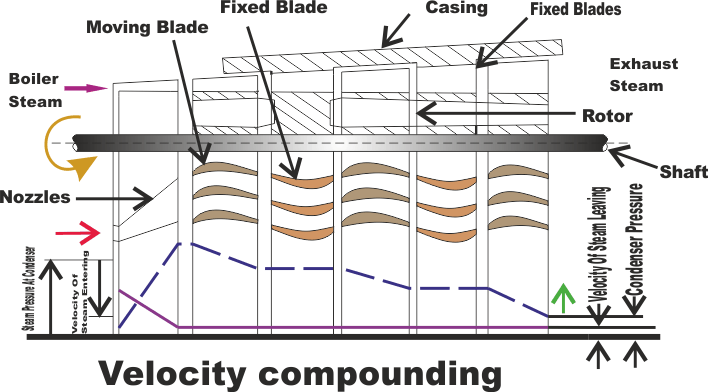Steam Turbine | Compounding Of Steam Turbine
☛ COMPOUNDING OF STEAM TURBINE
To improve the thermal efficiency of any power plant, generally high pressure (near about 120 to 140 bar), high temperature and high-velocity steam is used. Steam expands from boiler pressure to the condenser in one stage. So, steam's pressure drop and it will increase its velocity.This high-velocity strikes the turbines rotor and the speed of the rotor becomes high.Compounding of steam turbine is used to reduce the rotor speed. It is the process by which rotor speed come to its desired value. A multiple system of rotors are connected in series keyed to a common shaft and the steam pressure or velocity is absorbed in stages as it flows over the blades. Generally, three different types of compounding are used to reduce the rotor speed of steam turbine.
1. Velocity Compounding
2. Pressure Compounding
3. Pressure Velocity Compounding
1. Velocity Compounding:-
In velocity compounding turbine, some moving blades, fixed blades and a set of nozzle are shown in figure. Moving blades are fixed to the shaft and fixed blades are attached to the casing. In the figure shows two or three rows of moving blades which are separated by fixed blades and these moving blades are just in reverse position from the fixed blades. Now steam pass through the nozzle or a set of nozzles where it is expanded from boiler pressure to the condenser pressure. Due to decreasing the steam pressure, its velocity becomes very high. This high-velocity steam first enters the first ring of moving blades where some portion of velocity is absorbed. Then it passes through the next ring of fixed blades. The fixed blades changed steam direction and direct to the second ring of moving blades. There is no change in steam velocity when it passes over the fixed blades.

Now steam passes through the second row of moving blades and its velocity is further reduced. Steam loose its velocity every time when it passes through the moving blades. So, steam leaves the turbine with a low velocity. So, we can see that the steam's pressure can only drop at nozzle and further pressure drop occurs either in the moving or fixed blades. Velocity and pressure curves on a base represent the axis of the turbine. This method is used in CURTIS TURBINE.
Advantages velocity compounded steam turbine:
1.This arrangement needs small space.
2. This is very reliable and easy to operate.
3.Initial cost is low for this arrangement.
4. Since nozzle's steam is considerable, the turbine does not need to work in high pressure and turbines structure need not be very strong.
Disdvantages velocity compounded steam turbine:
1.Friction loss is high due to high velocity of steam of nozzle.
2.Its efficiency is low. Because the ratio of blade velocity and steam velocity is not optimum.
3. First, row is developed maximum power in this system. Later rows are developed very small power rather than first row.. But fabrication and cost of materials will be same in all rows.
2. Pressure Compounding:-
In pressure compounded turbine, moving blades and fixed nozzles are shown in fig. It consists of a number of fixed nozzles which are placed between the moving blades which means the ring of moving blades are separated by the ring of fixed nozzles. The moving blades are keyed on a same shaft in series. Now the steam of boiler pressure enters the first set of nozzles but does not drop the total pressure in one set of nozzles. The total steam pressure is dropped by number of stages and each stage consists of a set of nozzles and a ring of moving blades.

The steam is coming from the boiler and enters the first set of nozzles. A small amount of pressure is drop here by which it increases its velocity. At first steam passes through the first set of moving blades where its pressure does not change but its velocity decrease. After that it passes to the second set of fixed nozzles, its pressure is further reduced and expanded again. Now steam is directed to the second set of moving blades where the velocity of steam is almost absorbed. This process is continuing running until it reaches condenser pressure. Since steam pressure is reduced by each set of nozzle, so velocity of steam entering the moving blades is almost reduced and it reduces the rotor speed. Velocity and pressure curves on a base represent the axis of the turbine.
This method is used in RETEAU and ZOELLY TURBINE.
3. Pressure-velocity Compounding:-
This method is the combination of previous two methods. This method is the combination of both pressure and velocity compounding. Here the set of nozzle rings is fixed at the beginning of each stage and pressure remaining constant of each stage. Diameter is comparatively large in stage for increasing the volume of steam at lower pressure. The total pressure drop of the steam is divided into stages and velocity obtained in each stage is also compounded. A pressure velocity compounded turbine allows a bigger pressure drop in each stage. That's why pressure velocity compounded method need less stage as compared to the other method. A CURTIS TURBINE is an example of pressure velocity compounded method. Pressure and velocity curve for this turbine is shown in fig.

